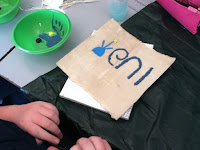We started with Roman Numerals and putting numbers into ascending and descending order. After looking at the numerals (most of them knew them already) and practising converting some numbers back and forth, we put a list of Roman Numerals into ascending order. Then we put Hindu-Arabic numbers (with different numbers of digits) in ascending order. Why was that easier? Not just because we knew the numbers better, but also because you could instantly see that longer numbers were bigger, which was not the case with Roman Numerals. Then we practised with some more ascending and descending order questions. (All this stuff is on a Prezi but it's a bit chaotic and just follows my mental lesson plan)
With two concepts off the list in one lesson, I went all out wasting time on the next one: Egyptian Numerals. This took a long time largely because we made our own fake papyrus out of old yellowed butcher's paper, then painted numbers on them, as well as learning about powers of ten, talking about how long multiplication works, multiplying Egyptian numbers the Egyptian way, and learning about the distributive law. But making the paper was the best bit! "I never expected Maths to be like this". "This is gross, but in a good way."
I don't think I've enjoyed the start of the year this much ever. And I have a beautiful display in my room:
















